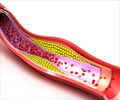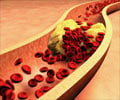Researchers have known that the bacteria that colonize the gastrointestinal tract of mammals influence their host's cholesterol metabolism for more than half a century.

In the study, the researchers added plant sterol esters to the diets of hamsters. The overall effect of this was to inhibit several bacterial taxa, from the families Coriobacteriacea and Erysipelotrichaceae, says Walter. But the immediate effect of the plant sterols was to physically block cholesterol absorption by the intestine. That decreased cholesterol levels in the liver and the plasma, prompting the hamster's body to respond by synthesizing more cholesterol. That, in turn, boosted cholesterol excretion into the gut, and that extra cholesterol was the direct inhibitor of those bacterial families.
"The abundance of these bacterial taxa and the levels of cholesterol in the fecal samples followed a mathematical model of bacterial inhibition," says Walter.
Practically speaking, the microbial inhabitants of the gut are part of the metabolic system. Researchers have shown that certain health problems are related to changes in the gut flora, such as can be induced by overuse of antibiotics. Since changes in diet can influence composition of the gut flora, health problems such as obesity might be targeted by dietary interventions designed to suppress bacteria that contribute to weight gain. "However, for these to be successful, we need to know which bacterial patterns not only are associated with disease, but actually contribute to it," says Walter, noting that his research showed that some alterations associated with metabolic disease might be the consequence, rather than the cause of the disorder.
Walter says that the work was a real student project. Among the coauthors, three were graduate students, and two were undergraduates. "As a supervisor, it is extremely nice to see young scientists work as a team, and staying dedicated through the five years that this project took to complete," he says.
Source-Eurekalert













